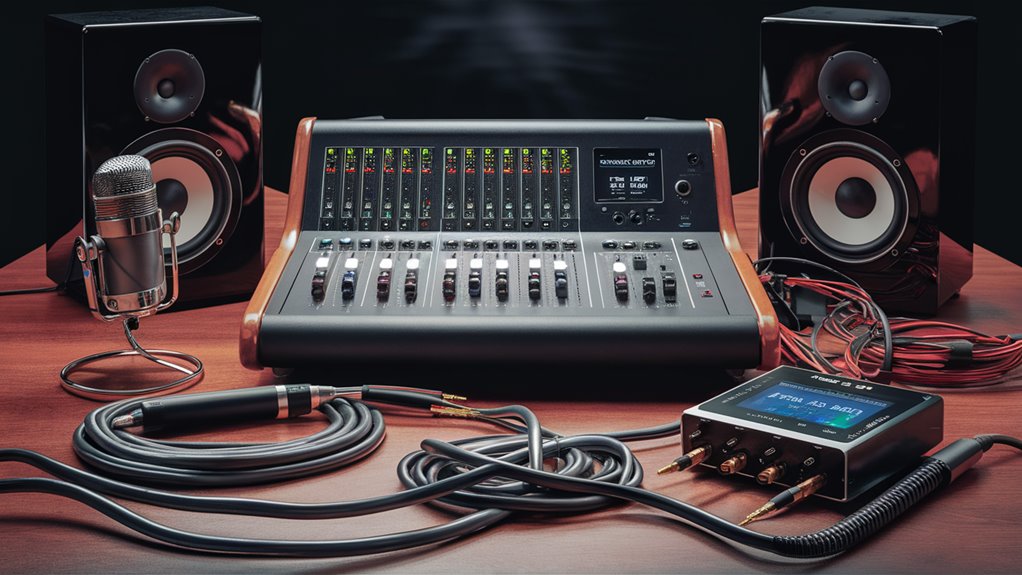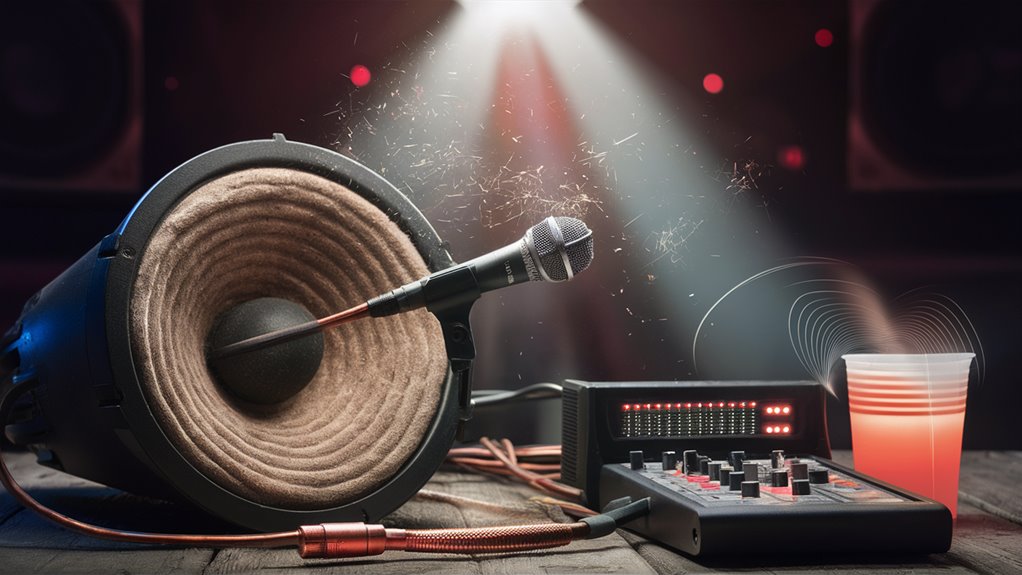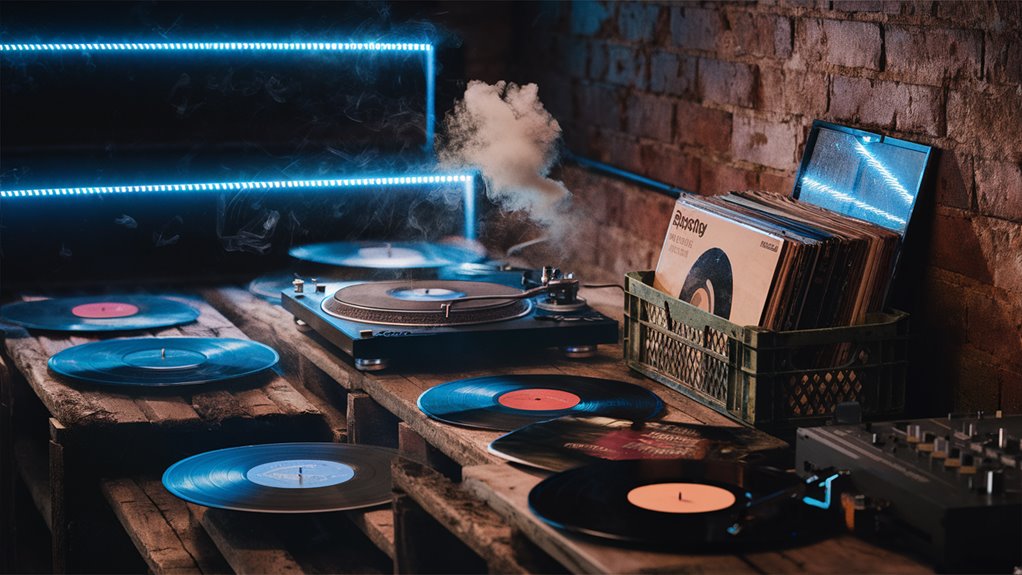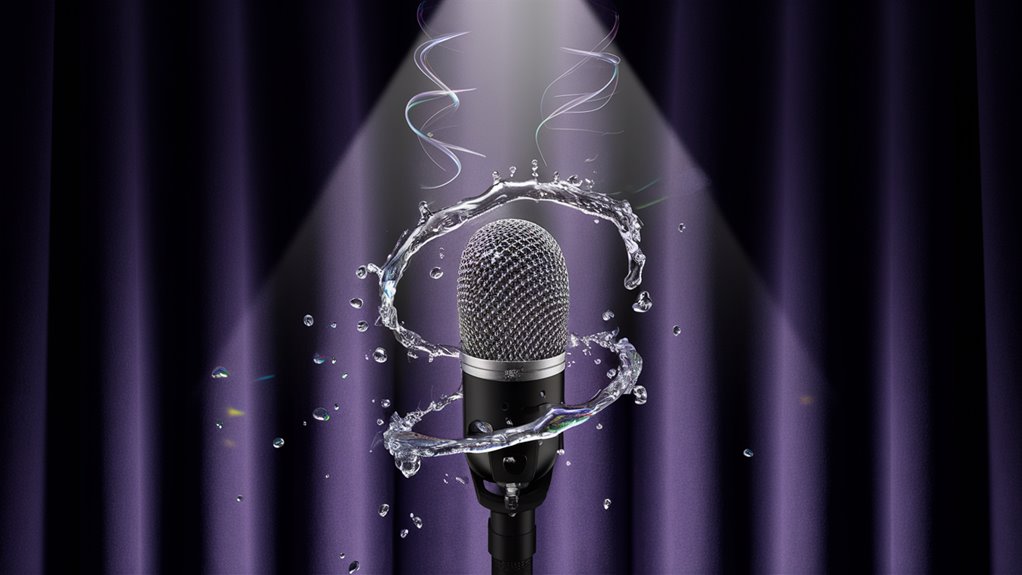Tips on Karaoke Sound and Gear

Needed Gear for Pros
Karaoke sound needs the right set. For pros, you need 100W RMS per sound path and a great mixer-amplifier at its heart.
Must-Have Gear
Cardioid mics pick up 50Hz-15kHz sounds and make sure voices sound clear. Pair these with good speakers, such as:
- 12-inch woofers
- Sharp tweeters
- 24bit/96kHz audio tools
- 3:1 sound compression
Room and Speaker Placement
Sound fixes in a room are key for best sound quality. You should use:
- 20-30% of walls with sound panels
- Speakers at your ear height
- Speakers angled 30-45 degrees towards you
- Even sound in the singing area
With the right gear, room sound, and setup, you can turn basic karaoke setups into pro sound systems with great sound throughout.
Key Sound Tips for Karaoke
Essential Sound Elements
The core of pro karaoke sound includes four key parts working well together. They lift the sound for fun singing times.
Mixer-Amp is Key
The mixer-amp is crucial. It manages sound paths and careful channel tasks. A min of 100W RMS for each channel helps keep sound even. It controls sound direction, volume, and keeps sound smooth.
Speaker Needs
Great speakers should match the amp’s power for top sound. The best sound frequency from 45Hz to 20kHz lets low and high sounds reach the crowd well.
Mike Specs
Cardioid mics are great for karaoke voices. These mics, with a range from 50Hz to 15kHz, block other noise and keep voices clean. This design ensures voices are clear and reduces other sounds.
Managing Sound Sources
The sound source, with karaoke units or digital setups, needs even sound levels and wide format use. Pro setup involves checking match and gain levels across all parts, cutting out harsh sounds and ensuring clear sound throughout the system.
All About Choosing Mics for Top Sound
Key Mike Features
Range is key in mic work. Pro mics cover from 50Hz to 15kHz, focusing on the 2kHz-8kHz voice zone. This band makes voices sound clear and warm.
Patterns and Noise Control
The cardioid pattern is best for voice tasks, reducing feedback and room noise. This shape catches sound from the front well while cutting other noise. Pro mics boost low sounds close to the mic.
Technical Points to Note
Handling sound detail needs good tests. Quality mics cut mechanical sounds by -20dB or more. Output needs ranging from 150-600 ohms fit well with today’s sound tools, while low self-noise, under 25dB SPL-A, keeps voices pure.
Pro Build
Dynamic mic build is best for stateful voice tasks. Built-in pop blockers and shock tools offer studio sound and solid build. These add pro-level sound in tough spots see more
Pro Speaker Setups for Great Sound

Best Speaker Setup
Pro speaker setups are essential for the best sound in karaoke games. Choose powered speakers with at least 12-inch woofers and special high-sound parts for full sound range. Bi-amped setups with 500-1000 watts per unit give room for top sound and clarity.
Where to Put Speakers
Place main speakers at ear height, angled 30-45 degrees for best effect. This design reduces feedback and makes words clear. For large places over 1000 square feet, use additional speaker setups for full sound throughout Tips for Non-Stop Fun
Smart Sound Fixes
Adjust your speaker system to room sound with real tests to find and fix tough sounds. DSP speakers let you adjust sound curves and limits correctly. For pro tasks, use cardioid sub setups to manage low sounds, stopping muddy noise that hides clear words. This wise step ensures sound is fine everywhere.
Digital Sound Tips for Pro Audio
Deep Sound Tasks
Digital work turns basic sound to pro level with smart tech and live tweaks. Today’s systems work sound at 24-bit/96kHz, making neat, well-set tunes. Many simultaneous tweaks give better sound, like cutting noise, stopping echo, and setting tone right.
Main Digital Points to Note
The main tech base relies on three big things: cutting latency, keeping feedback low, and making voices nicer. Top mic amps turn sound to digital fast, keeping music and voice in sync. 32-bit floating tasks give room for hard effects while keeping digital noise out.
Smart Room Sound and Dynamic Touch
Smart room adjustments use fine mic tests to set sound response for each sound area. The system’s auto level control keeps sound even, while smart compression keeps range good without ruining sound clarity. Pro harmonizer moves tune voice just right, keeping it natural while fixing small off-notes.
Top Guide for Room Sound in Karaoke Setup
Room Size and Setup Musts
Great sound needs smart choices of room shape and setup. Rooms from 300-500 square feet spread sound well and miss waves that happen in square places. The best room setup boosts voice clarity and reduces unwanted sound bounces.
Pro Surface Fixes
Sound fixes on walls should cover 20-30% with a mix of broad catchers and breaks. Getting the right balance across all sound levels is key for pro sound. Keep similar surfaces apart to stop echoes that hurt voice clarity and sound quality.
Smart Speaker Spots and Sound Care
Best speaker spots follow the 38-degree sound rule from where you sing. Hang speakers at ear level, slightly tilted down, keeping them some way from walls to reduce edge sound effects. Sub spots need careful corner tests for top low sound and steering clear of boom places throughout the singing area.
Sound Issues Common in Karaoke Gear
Main Tech Problems and Fixes
Sound issues in karaoke often come from five big tech problems that affect how it works and feels. Spotting and fixing these usual issues is key for best sound delivery.


